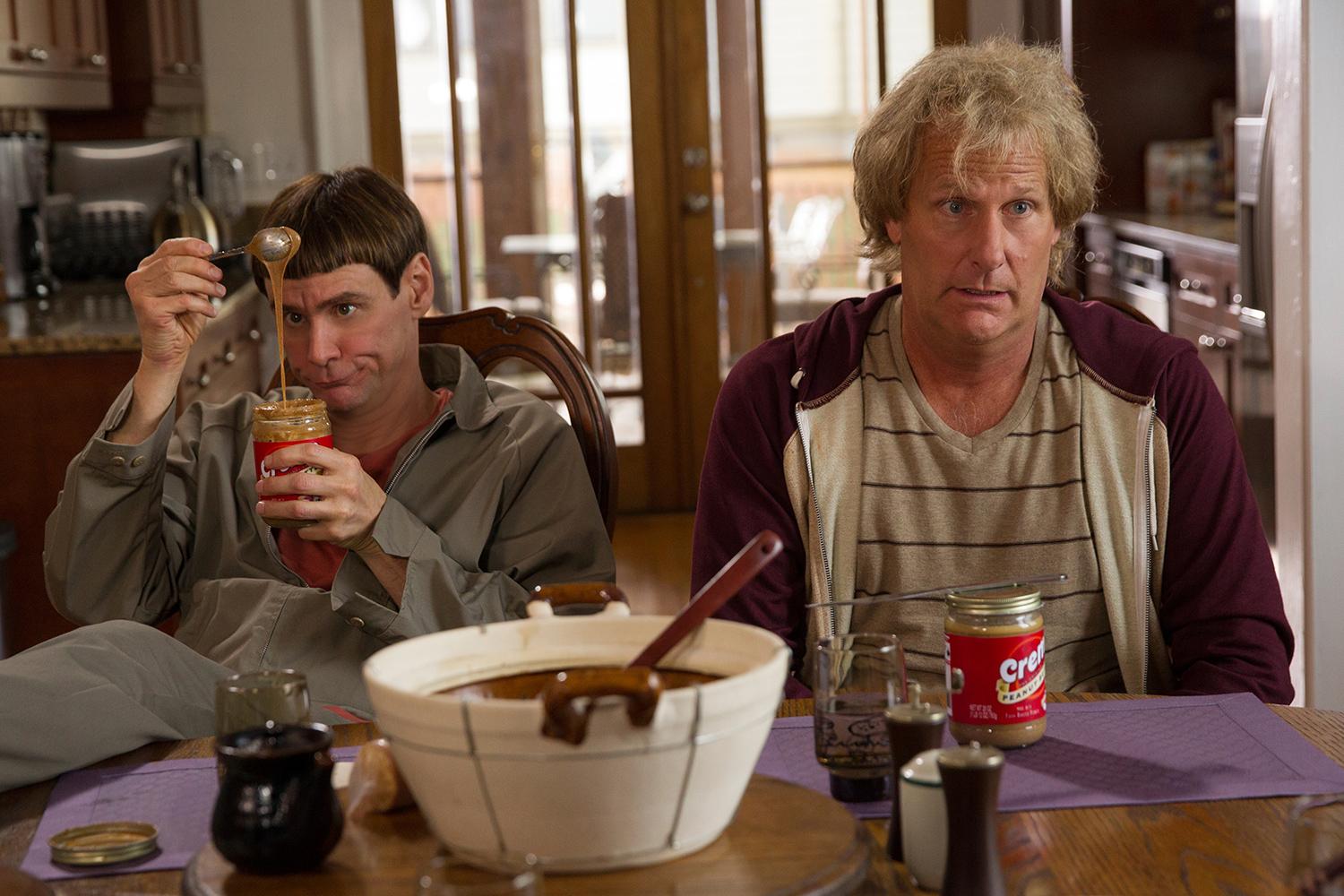Whatever else there is to say about Dumb and Dumber To, there’s this: the movie lives up to its title, and then some.
Released almost exactly 20 years after its 1994 predecessor, Peter and Bobby Farrelly have re-teamed with Jim Carrey and Jeff Daniels for the long-awaited reunion of infamous idiots Lloyd Christmas and Harry Dunne. (And yes, this is definitely the first time Harry and Lloyd have met since 1994. There’s definitely no such thing as a Dumb and Dumber prequel. Definitely, definitely not.) It’s the only sequel in the Farrelly catalogue, even if it’s one that’s been on the director siblings’ minds since the first film’s release two decades ago. Was it worth the wait? That depends. How dumb do you like your movies?
Was it worth the wait? That depends. How dumb do you like your movies?
Because, make no mistake: Dumb and Dumber To is dumb —almost courageously so — right from the setup. Twenty years of real-time have passed since Harry and Lloyd left Aspen. In all that time, Lloyd’s been holed up in a psychiatric facility, completely immobile, reliant on a catheter, unable to speak. His beard is like a bird’s nest, his hair almost down to his back; the bowl-cut bangs, of course, remain.
Harry has been visiting Lloyd every single Wednesday for the past thousand years. (His measurement of time, naturally.) But it’s time for him to move on. He’s suffering from a health problem — his kidneys are failing — and he’s off to seek treatment. Finally, just as Harry says his final goodbye, Lloyd stirs. Grunts that sound like words break free from his lips, slow and unformed at first, then faster, faster and faster still until it’s an unmistakable laugh-in-your-face declaration:
“GOT YA!”
That’s right: Lloyd was punking Harry, willingly wasting away “the best years of [his] life” all for a gag. But what a gag! And if you think that’s moronic, just sit through Dumb and Dumber To and behold as the Farrelly brothers pull off the same prank, albeit under two hours instead of across two decades. Lloyd and Harry’s special brand of idiocy transcends the characters and permeates the entire film, as the two dimwits once again embark on a cross-country road trip, seemingly about a girl, but really about nothing at all.

The Farrellys have returned to Lloyd and Harry’s world not exactly as they left it, but pretty close. Blind Billy still lives in Apartment 4C. Freida Felcher from Cranston remains a legendary figure in Harry and Lloyd’s lives, albeit more present in this one than the first film, with Kathleen Turner in the role. Some very bad people are very mad at Harry and Lloyd for messing with their plans, even though the brainless buddies have no idea about the problems they’re causing — just like last time. Of course, the Mutt Cutts van is still somewhere out there as well.
There are some new coats of paint, quite literally in the case of Rob Riggle, playing a pair of twin brothers looking to stop Harry and Lloyd from screwing up their master plans. Riggle’s a welcome addition to the Dumber world, especially as the spec ops sibling; seeing Riggle walk around in vending machine camouflage like a stone-cold Terminator does not suck.
What’s a few thousand brain cells between friends?
But by and large, Dumb and Dumber To is just like last time, all this time later. Most importantly, Jim Carrey and Jeff Daniels are exactly as they were back then: dumb and getting dumber with every passing scene and increasingly bad idea. It’s pretty amazing just how well Carrey and Daniels fit back into the roles, considering the work they’ve accomplished over the past 20 years. The actors who went on to star in films and shows like Eternal Sunshine of the Spotless Mind and The Newsroom have not lost their touch when it comes to playing these morons.
And that’s the real draw of Dumb and Dumber To. Carrey and Daniels are Lloyd and Harry all over again. These characters, dormant for 20 years (again, without a prequel, because that did not happen, not no way not no how), are back in business. If you don’t like those guys, then you already know to stay away. If you do like them, then you’ll at least get some big laughs out of seeing them together again. In the end, what’s the harm in seeing Harry and Lloyd together again, even if their reunion isn’t as fun as the first party?
Put another way: What’s a few thousand brain cells between friends?
Dumb and Dumber To hits theaters this weekend.
(Media © Universal Studios)
Editors' Recommendations
- 5 movies leaving Netflix in April 2024 you have to watch now
- Where to watch How the Grinch Stole Christmas (all versions)
- The School for Good and Evil review: Middling magic
- Rosaline review: Kaitlyn Dever lifts up Hulu’s Romeo and Juliet rom-com riff
- Halloween Ends review: a franchise mercy kill






